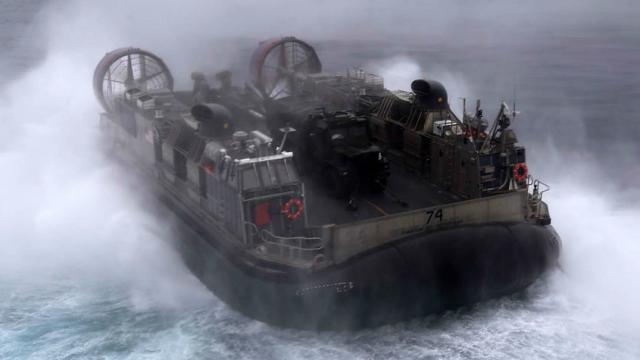There’s no guarantee that the USMC’s UHAC next-generation landing craft will ever see the light of day. Until that actually happens, the US military will continue to rely on these nearly unstoppable ship-to-shore hovercrafts.
The Landing Craft, Air Cushion (LCAC) is a 26.52m long, 14.33m wide hovercraft employed by both the US and Japan as a fast-moving landing craft for storming beachheads and delivering both crews and supplies to shore from littoral vessels. Four gas turbine engines supply energy to four centrifugal fans which help form a cushion of air within the envelope of rubberised canvas underneath the LCAC. Like Zuul, the LCAC floats four feet above the ground at all times.
Each $US200 million LCAC can hoist up to 75 tons of gear and equipment (that’s roughly an M-1 main battle tank) or 180 fully equipped troops) from an offshore well-deck support ship and shuttle it ashore at speeds topping 72.42km/h (about 40 knots, though it can hit 70 knots when unladen). What’s more, the LCAC is entirely unfazed by obstacles and pitfalls like shallows, reefs, or sea mines that would beach other landing craft.
However that speed comes at a price, namely in its handling and fuel efficiency: the LCAC has a 1828m turning radius and needs at least 457m to stop. Plus, it sucks through a 18,900L fuel reserve in just five hours. Keeping 60-75 tons of stuff floating four feet above the ground is, unsurprisingly, a very energy-intensive task. Still, even with that burn rate, the LCAC can cover over 80km a leg for its deliveries, allowing the fleet to remain hidden over the horizon while remaining within striking distance.
LCAC’s first entered service in 1987 with the USS Germantown and can now be found aboard every amphibious-well deck ship in the fleet. 91 LCACs have been produced altogether with 36 currently operating off of each coast. In fact, given the LCAC’s capabilities, only about 20 per cent of the entirety of the Earth’s coastline are inaccessible. The TK, that the LCAC replaced, could only muster about 17 per cent of the Earth’s coast and could only shuttle forces from about 3km out.
They perform a number of functions beyond transport including mine-sweeping, humanitarian relief and special forces operations — though the overwhelming levels of noise and dust that this thing kicks up make it decidedly unstealthy. Still, the LCAC has proven itself a valuable — albeit expensive to maintain and rather dangerous to operate — asset to America’s fighting forces, supplementing the role of troop transport choppers for over the horizon (OTH) operations.
And with the latest rounds of technological upgrades — including modernized electronics and redesigned components — as part of the Service Life Extension Program, the LCAC is positioned to remain an active part of the US military machine for at least the next two decades. [Wiki – FAS – US Navy]
Top Image: Lance Cpl. Laura Y. Raga / USMC
